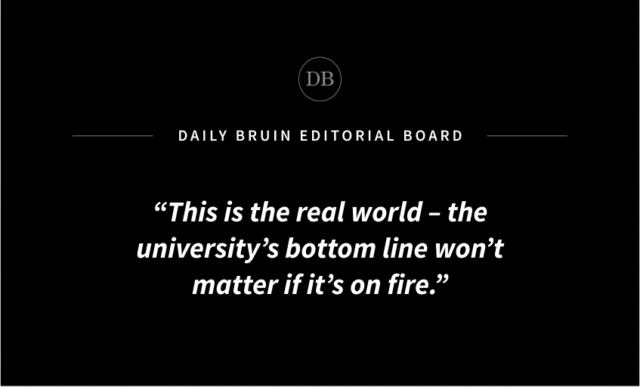This post was updated August 7 at 10:10 p.m.
Achieving carbon neutrality by 2068 by funneling money into dubious mitigation schemes is far too little, far too late.
Back in November 2013, former University of California President Janet Napolitano committed the campuses to becoming carbon neutral by the year 2025.
Carbon neutrality refers to having a net-zero balance between the carbon emitted by an organization’s activities and emissions the organization pays another party to reduce. Likewise, the UC’s Carbon Neutrality Initiative doesn’t specify that its campuses must reduce their emissions – just that they have to pay external entities to reduce their emissions by the amount they are continuing to put out.
While UCLA is taking measures to decrease its carbon emissions, it’s being done too slowly, at a rate of about 2% per year. And with steady yearly increases in the campus’s direct carbon emissions, UCLA is on track to become carbon-neutral by 2068, more than four decades after the 2025 goal.
As a self-proclaimed leader in sustainability, UCLA must implement stronger sustainable strategies to get back on track with its 2025 goals and act as a role model for leaders across the globe.
After all, there is no amount of money that could eclipse the value of our future.
As a result of climate change, the world is already experiencing longer-burning wildfires, increased flooding, persisting drought conditions and more intense hurricanes. Furthermore, the positive feedback loops of climate change make reversing these trends ever more urgent.
Global leaders need to put their money where their mouth is – and that includes UCLA.
Our university has fallen into a deadly pattern. Sustainability goals are set, plans are put in place, but then there is little execution. Instead, these real problems are met with shallow advertising campaigns. Take, for example, Zero Waste by 2020 and the initiative to reduce the university’s water consumption by the same year, both disheartening failures.
Even worse, instead of learning from these failures, the University is set only to repeat these mistakes with its other sustainability strategies.
Much like the Zero Waste campaign, the Carbon Neutrality Initiative is not what it seems. Rather than cutting our campus’s direct emissions, action has been taken to offset our carbon emissions by paying other parties to reduce their carbon footprints. This allows them to find the most inexpensive way to ensure our university’s operations do not result in a net increase in atmospheric carbon – in theory, at least.
In reality, there’s no guarantee that the methane UCLA has been paying landfills in other states to burn would have been released into the atmosphere without our intervention.
Our campus is trying – and failing – to become climate-friendly on paper, and that’s about it.
Moreover, even if this plan is effectively reducing emissions, it isn’t doing so with the leadership and innovation we so desperately need from institutions such as UCLA.
Instead, our university must invest in ground-level methods of fulfilling its obligations to combat the climate crisis. While buying offsets is a good short-term effort, it should only be the start of honest environmental efforts.
Right now, UCLA should be committing to an aggressive timeline to both divest from and stop burning fossil fuels. Such a commitment must come with detailed steps for follow-through, publicly available goal-tracking and well-defined accountability measures.
In the long run, this will do much more than reduce UCLA’s direct contribution to climate change. The university has an opportunity to improve local air quality, foster climate-friendly innovations, fight environmental injustice and set an example for other institutions as well as its own student body.
Sustainability doesn’t exist on a spreadsheet, nor do our actions exist in a vacuum.
This is the real world – the university’s bottom line won’t matter if it’s on fire.
It’s past time our leaders started acting like it.


Comments are closed.